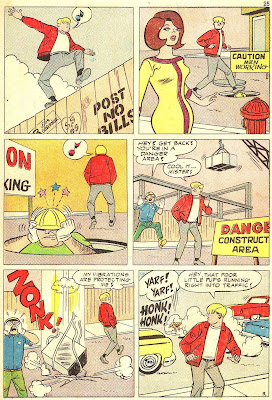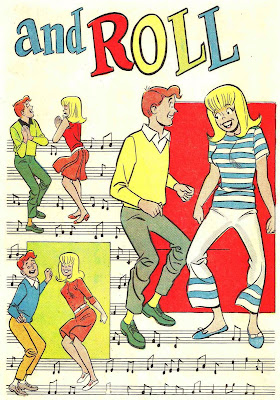When Samm Schwartz arrived at Tower Comics in 1965 to be editor and artist of Harry Shorten new pulishing house, he closed down a 14 years productive cycle working for MLJ/Archie Comics. His friend Joe Edwards introduced him to the company in 1942, a year after Archie made his first appearance in Pep Comics series pages. Next to some early superhero works, he’d become the main artist of Archie’s Pal Jughead.
Schwartz was a developed artist in those days, he had found already a distinctive method of his own by means of a series of artifices that, in the course of time, they ended up turning into some instinctive thing. And this, in a company like Archie -with a noticeable stylebook, it wasn’t just unusual, but a self-improvement exercise as well. It was others, like Harry Lucey, who get around the “Dan DeCarlo” stigma, but anyone like Samm Schwartz.
Despite the fact he’s primarily known for his labor on Jughead series (something that guarantees Schwartz a place in the comic history by itself), I’m discretely fond of Tippy Teen series and its spinoff Tippy’s Friends Go-Go and Animal. Amongst the reasons I can find to explain the magnetic deflection to this series are that they’re characters created by Schwartz himself, the particular period in which they happened to be born or that they’re lasted no more than four years.
Inside the humor teen genre, Tippy doesn’t provide any new features. It’s another inventory of youth banality: characters’ life is a common roll of trivial pursuits, frivolity, ulterior motives, and sexual tension buried under huge spadefuls of boggy naivety. But Tippy was born in the peak of the counterculture movement and, although the series grows indifferent to the sociocultural changes of the well known decade of ideologies, it’s in the superfluous bent to the icons that represent them where lies the weird charm it evokes. In the end, the look wouldn’t be as aggressive as it might be taking into account the possibilities (it never takes on psychedelia, for instance, as it does Harvey Comics in Bunny series (1966)), remaining as a light reading of the period that just the passage of time has managed to turn into a peculiar allure.
As Don Markstein reminds us over at Toonopedia.com, most of the comic book fans usually recall Tower Comics thanks to THUNDER Agents, a series created by Wally Wood. But the fact is that Tippy Teen was the most outstanding title, provided that we take into consideration the issues published linked to Tippy’s world in its entirety.
Tippy Teen #1 was launched November 1965 and, like other Archie rip-offs, it didn’t mean to hide its feed source. Actually, it adapted to the formula unabashedly:
“Tippy’s boyfriend, Tommy, had a relationship similar to Archie’s with Betty, in that both were free to date others, and sometimes did. Her best friend, Go-Go West, had a boyfriend called Animal, and the two of them resembled Archie’s classmates Big Moose and Midge, except Animal wasn’t as possessive as Moose.”
While it’s true to say that this first 65-pager is packed with run-of-the-mill stories, the art is tops. So, you can find in its pages none other than Harry Lucey, Dan DeCarlo and Vincent DeCarlo, Doug Crane and Samm Schwartz himself. That is, the cream of Archie Comics crew. “Wig Warm” y “You’ve Gotta Have Art” lies in his hands.
Between the stories there were slices of fashion trends too where the characters used to dance displaying their up-to-date outfits. They’re regular sections where the readers wrote the editor suggesting their own designs. A kind of inverted Cosplay, as Tim Hensley well notes: here the readers dress up the characters. You can see more examples over at Blog Flume provided by Hensley himself.
He did not usually write his own stories. As he himself admitted, it was a tiring tenure: “It’s on your mind 24 hours a day. It’s much easier for me to draw a person doing something than describe it,” he said. “Afterward, I didn’t have energy to draw.” Chances are that, for the most part, someone else took care of the plot, leaving space so that our man could improvise on dialogs and adding background gags, setting up an alternative reading level.
Schwartz’s style has a series of trademarks that, so often, we can find them all in once in just a story: from chewy poses to a simplified drawing on the verge of minimalism (never beyond permissible bounds of “Archie” stamp), silhouettes, scenes without superfluous objects or details, empty spaces as backgrounds, panels without borderlines and an undramatic inking are some of them. There are other valuable features to consider when you try to tell the difference between him and other contemporary colleagues, such as his marvelous reading of the wrinkles on clothes, the way pants “quiver” when the character is excitedly moving or his skill drawing shoes no matter the point of view (no kidding, he was the best on it).
Certainly, Schwartz wasn’t an easy-going artist: he pincelled, inked and lettered most of his work, and his style would keep evolving, stylizing, to reach its pinnacle in the mid of ’70s. Despite it, Tower’d fold in 1969 and, after a brief spell at Dc Comics, he’d come back to the company that see him started out:
“Schwartz’s work after coming back to Archie was even better than it had been before, loosened up by his experience at Tower. He started throwing in more crazy background gags of his own, and returning to the ’40s/’50s style of not respecting the boundaries of the panels: characters’ legs and arms would protrude from one panel to another, they would stand on the speech balloons of the people in the panels below them.” (Jaime Weinman, Something Old Nothing New)
A high quality work that remains in full force thanks to heirs like Tim Hensley and his dadaist interpretation of both the genre and his devices and, in a veiled way, the Hernandez Bros, distinguish him as one of the humor teen comics master.
The last stories ending this post are great examples of Schwartz’s fine art. Actually the gasping last two panels of the last one are reasons enough to include it here! Besides, I think that there’s no digital copies of this issue on the net.
 Interesting links on Samm Schwartz:
Interesting links on Samm Schwartz:Jaime Weinman on his work (the best comments about Samm you can find in the blogosphere to date): Here – here – here – here – here
Original art by Schwartz here!
Joanne talks on his father here.
Schwartz and Little Archie (provided by good ol’ Doug Gray) here.
Pictures and stuff here.
Stupid Comics being cruel to the series here.
Another Tippy Teen story -erroneously attributed to Schwartz, IMHO: here.






































Leave a Comment